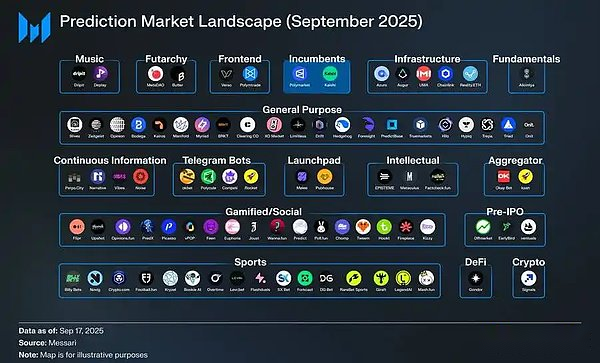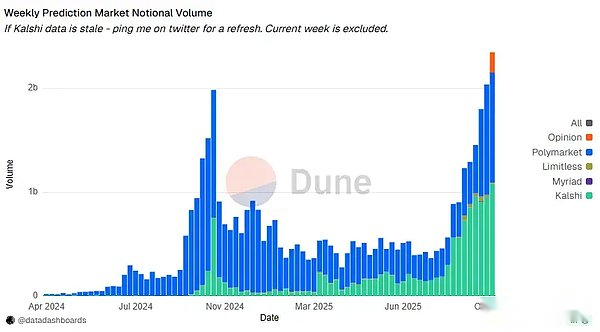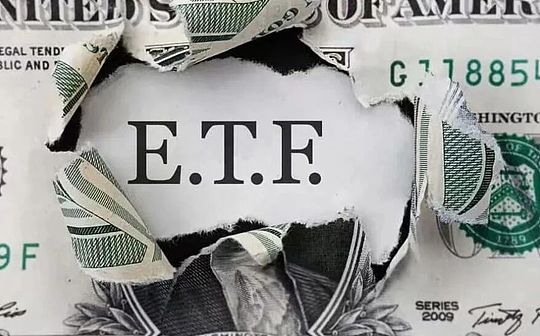
pickwant
The prediction market started from the Iowa Electronic Market and academic and betting exchanges such as Betfair, to the Augur chain experiment based on Ethereum, and then to Polymarket (decentralized route) and Kalshi (compliant financial route) to form the current duopoly pattern, and new platforms such as Opinion, Limitless, and PMX Trade have emerged in vertical fields such as sports, crypto assets, and the creator economy.Innovations with real potential are shifting from “rebuilding a platform” to event contract primitives and infrastructure – developing perpetual, options, indexes, lending and “smart AMM” around YES/NO shares, as well as “shovel businesses” such as data terminals, aggregate routing, Bot, middleware and compliance technology.In the future, the prediction market is expected to become an “information pricing layer” embedded in social media, news and financial terminals, while entrepreneurship and investment opportunities will mainly focus on key infrastructure directions such as rules and oracles, liquidity and capital efficiency, distribution and interaction, compliance and AI integration.
1. Forecast market historical evolution and industry patternbureau
As a mechanism for pricing future events, prediction markets have evolved over more than thirty years and have gradually developed from academic experiments and gray edge gambling to an independent asset class with information value, liquidity scale and financial attributes.This type of market is based on the structure of “price is probability” and uses real funds to map market participants’ comprehensive judgment on the probability of a certain event: a binary contract with a settlement of US$1 or US$0 has a trading price between US$0-1, directly representing the market consensus.For example, when an event contract price is $0.62, it means “the market believes the event has a probability of happening about 62%.”This opinion aggregation mechanism based on dispersed participants essentially builds a quantifiable, verifiable, and real-time updated information public good. It is not only different from recreational gambling, but also different from the binary options banker structure, but a hybrid information financial infrastructure that combines market efficiency, group wisdom, and dynamic trading capabilities.Different from the negative-sum mechanism of gambling, the overall structure of the prediction market presents a “positive-sum information output”: the platform charges a small fee, and the core value comes from the probability signals aggregated by the market.This signal can be quoted by the media, modeled by research institutions, used by enterprises for risk management, and can also be directly embedded as a pricing node in other financial derivatives and Web3 protocols, which has strong externalities and social value.
The roots of modern prediction markets can be traced back to 1988 with the Iowa Electronic Markets (IEM).This is an early experiment led by academic institutions that allows participants to trade contracts with small amounts of money that represent a candidate’s winning rate or vote rate, with the express purpose of improving prediction accuracy.A large number of studies have shown that between 1988 and 2004, IEM’s prediction performance for the US election was significantly better than most traditional polls, and its probability signal has the ability to reflect the true trend earlier.

What will really drive the industrialization transition of the prediction market is the new generation of platforms with mature Layer 2, stablecoins, and cross-chain infrastructure after 2020, represented by the “duopoly pattern” formed by Polymarket and Kalshi in 2024-2025.Polymarket represents the full maturity of the decentralized route: based on Polygon and multi-chain extensions, it achieves a product form that combines experience and censorship resistance through the order book model (CLOB), low-friction deposits, gas-free transactions and UMA’s optimistic oracle.During the 2024 U.S. election, monthly transaction volume reached US$2.6 billion, and cumulative transactions throughout the year exceeded US$10 billion.Its communication effect in the media and social networks has significantly built a flywheel of “opinion → position → communication” and has become the preferred platform for Web3 users to enter the prediction market.Even after being punished by the CFTC, it restructured the US market by acquiring the licensed exchange QCEX, further demonstrating that compliance has become the core direction of track development.Kalshi, which developed in parallel with Polymarket, represents a completely different path: compliance, regulatory certainty and penetration of mainstream financial channels.Kalshi obtained the CFTC Designated Contract Market (DCM) qualification in 2021 and subsequently completed the clearing license (DCO) to become a U.S. federally compliant event contract exchange.Its centralized matching structure is closer to traditional exchanges, supports USD and USDC deposits, and provides event contracts directly on mainstream investor interfaces through cooperation with brokers such as Robinhood.After the outbreak of sports and macroeconomic contracts in 2025, Kalshi’s weekly turnover once reached 800-900 million US dollars, with a market share of 55-60%, becoming the de facto infrastructure of the local prediction market in the United States.Different from Polymarket’s on-chain openness, Kalshi’s advantage lies in the institutional participation, brand trust and traditional channel distribution capabilities brought about by compliance certainty. The two constitute the orthogonal dual core of “on-chain composability” and “compliance availability”.
In addition to the two-headed structure, new platforms and vertical tracks are rapidly emerging, further expanding the market boundaries.Opinion relied on BSC ecological traffic and airdrop incentives to exceed hundreds of millions of dollars in the first week of its launch; Limitless meets crypto traders’ needs for volatile products through short-cycle price predictions within the Base ecosystem; PMX Trade in the Solana ecosystem directly tokenizes Yes/No contracts to explore the deep integration of prediction markets and DEX liquidity.Sports-related platforms such as SX Network, BetDEX, and Frontrunner have become the largest vertical scenarios due to their high frequency and high stickiness, while the “creator economic prediction market” represented by Kash, Melee, and XO Market directly financializes opinions and turns KOL’s opinions into tradable assets.At the same time, TG Bot and aggregator tool chains represented by Flipr, Polycule, okbet, etc. are becoming another rapid development direction. They compress complex prediction interactions into the chat interface, provide cross-platform price tracking, arbitrage, and capital flow monitoring, forming a new “1inch + Meme Bot” ecosystem for prediction markets.
Overall, the prediction market has gradually completed three leaps in its thirty years of evolution: from academic experiments to commercial gambling exchanges, and then from on-chain experiments to dual-core platforms with compliance and scale, and finally differentiated into highly diversified forms in vertical scenarios such as sports, crypto markets, and the creator economy.The window period for general-purpose platforms is narrowing, and the real increase is more likely to come from deeply vertical scenarios, the data and tool layer around the ecosystem, and the degree of integration of forecast market signals with other financial systems.The prediction market is accelerating from a “gray edge toy market” to an “important infrastructure of the global information and financial system.”
2. The structure of the prediction marketchallenge
After more than thirty years of iteration, the prediction market has moved from an experimental product to a financial-level infrastructure stage where global users and institutions are gradually participating. However, its development still faces three structural bottlenecks that cannot be circumvented: supervision, liquidity and oracle governance.These three do not exist independently, but are interrelated and restrictive of each other, determining whether the prediction market can grow from “gray innovation” to a “compliant and transparent global information and derivatives system.”Regulatory uncertainty limits the entry of institutional funds, and insufficient liquidity weakens the effectiveness of probabilistic signals. If oracle governance cannot provide a reliable ruling mechanism, the entire system will fall into a quagmire of game manipulation and outcome disputes, and will not truly become a trusted source of information for the outside world.
Regulatory issues are the primary bottleneck for prediction markets, and their complexity is particularly prominent in the United States.Whether the prediction market is a commodity derivative, gambling, or a security-style investment contract, different characterizations correspond to different regulatory paths.If it is regarded as a commodity or derivative, it will fall under the supervision of the CFTC and be treated the same as a futures exchange. It will need to apply for a DCM (Designated Contract Market) and a DCO (Clearing Organization) license. The threshold is high and the cost is high. However, if it can pass, it will obtain legal status at the federal level. Kalshi is a typical case.If it is considered gambling, you need to apply for gambling licenses in each of the 50 states. Compliance costs rise exponentially, almost blocking the possibility of a national platform.If it is regarded as a security, it will trigger strict supervision by the SEC, posing huge potential risks to DeFi prediction protocols with token design or return commitments.The fragmentation and overlap of the U.S. regulatory system has placed the prediction market in a gray area of repeated controversy.For example, the core dispute in Kalshi’s lawsuit against the New York Gaming Commission is whether the CFTC has the exclusive authority to regulate event contracts.This verdict is not only about whether Kalshi’s business can be successfully carried out across the country, but also about the institutional course of the U.S. prediction market in the next ten years.In addition, the CFTC’s enforcement against Polymarket and its identification of Crypto.com’s sports event contract illustrate that regardless of whether the platform shell is “decentralized” or not, as long as it provides a front-end to U.S. users and facilitates transactions, it will essentially be regarded as an unregistered compliance activity based on derivatives or binary options and will need to bear corresponding legal liability.
Outside the United States, jurisdictions around the world have generally continued the “dual framework”: integrating prediction markets into the gambling regulatory system or into the financial derivatives system, but rarely establishing new laws specifically for prediction markets.The UK, France and other countries are open to event betting under online gambling supervision, but regulatory tools include geo-blocking, payment bans, and ISPs blocking, making it difficult for prediction market platforms to reach mainstream users before obtaining a license.For entrepreneurs, the defense of “technology neutrality” is no longer enough to avoid legal risks, and neither offshore companies, DAOs, nor decentralized front-ends can ensure immunity from regulation.There are only three paths to long-term survival: either embrace licenses like Kalshi; or remain completely offshore, completely open source and decentralized, and accept the cost of absence from the mainstream market; or turn to compliance infrastructure and provide technical services (KYC, risk control, predictive data API, etc.) to licensed institutions.Regulatory uncertainty limits the participation of institutional funds and the depth of connection with traditional finance, making it difficult for prediction markets to truly expand in scale.
3. Value innovation and future opportunities in the forecast marketencounter
After the prediction market has gone through several rounds of reshuffles from the three major constraints of regulation, liquidity and oracle governance, truly valuable innovations have begun to migrate from “single platform competition” to the “primitive layer” and “infrastructure layer”.To simply understand, what everyone has been doing in the past ten years is “a new prediction market website”; in the next ten years, the increase is more likely to come from “abstracting event contracts into information derivatives and embedding them into the entire DeFi and financial system”, turning the prediction market from an application into a DeFi Lego brick that can be spliced together.The binary contract of the event itself is just the starting point of everything. When the contract becomes a standardized, combinable, and mortgageable asset unit, a whole set of derivatives layers such as perpetuals, options, indices, structured products, loans, and leverage can naturally grow around it.The “event market” explored in D8X, Aura, and even some dYdX v4 designs essentially projects “whether it happens” into the 0–1 price space, further allowing for highly leveraged trading, allowing traders to not only bet on the direction of events, but also trade volatility and sentiment.A protocol similar to Gondor allows users to mortgage Polymarket’s YES/NO shares to lend stablecoins, converting long-term event positions that were originally statically locked into reusable mortgage assets. The protocol then dynamically adjusts LTV and liquidation logic based on market probabilities, and financializes “views” into recyclable capital instruments.Further up, there are indexing and structured products similar to PolyIndex, which package a basket of events into ERC-20 index tokens, allowing users to obtain comprehensive exposure to a certain topic with one click, such as the “U.S. Macro Policy Uncertainty Index” or the “AI Regulation and Subsidy Implementation Event Basket.” In the context of asset management, the prediction market is no longer an isolated market, but has become a new asset class that can be included in the portfolio allocation of asset managers.

The “shovel opportunities” that truly have mid- to long-term value are concentrated at four levels.The first is the truth and rules layer, which is a new generation of oracles and arbitration protocols.How to avoid the recurrence of UMA-type disputes in terms of economic incentives and governance structures, and how to use standardized and modular tools to help ordinary users create an event market with “clear rules and adjudication” will directly determine the extent to which the prediction market can be accepted by institutions and public departments.The second is the liquidity and capital efficiency layer. The AMM, unified liquidity pool, mortgage lending and income aggregation protocol customized around the prediction market can convert dormant event positions into reusable assets. This not only brings new asset classes to DeFi, but also brings a thicker economic moat to the platform.The third is the distribution and interaction layer, including social embedded SDK/API, media one-click access components, professional terminals and strategy tools. These directions determine the “entry form” of the prediction market, and also determine who can stand at the intersection of information and transactions to earn continuous handling fees and technical service fees.The fourth is the compliance technology and security layer, which focuses on refined geo-fencing, KYC/AML, risk control monitoring and automatic reporting in multiple jurisdictions to help licensed institutions securely access forecast market data within the scope of regulations and allow event prices to truly enter the asset management, investment research and risk management processes.Finally, the rise of AI provides a new closed loop for the binding of prediction markets and capital markets.On the one hand, the AI model can serve as a “super trader” in the prediction market with stronger information processing and pattern recognition capabilities to trade, which in turn improves market pricing efficiency; on the other hand, the prediction market can also serve as a “practical scoring field” for AI capabilities, quantitatively evaluating model quality through indicators such as true profit and loss, long-term calibration, and providing an external, hard-constrained evaluation system for “AI research reports, AI investment consulting, and AI strategies.”For investors, projects that understand derivatives design and can safely use event prices within regulatory boundaries while building a bridge between AI and traditional finance are likely to grow into key infrastructure assets for the entire “information derivatives” track in the next cycle.
Four.knotOn
From betting on the papal election in the 16th century, to predicting the president on the streets of Wall Street in the 20th century, to IEM, Betfair, Polymarket and Kalshi, the evolution of the prediction market is essentially a history of human attempts to use systems and incentives to approach “more realistic probabilities”.Today, when trust in mainstream media continues to decline and social platform signals are mixed with noise, prediction markets use prices to materialize the “cost of saying the wrong thing” and compress the information and judgments scattered around the world into a quantifiable and verifiable probability curve.It’s not a perfect truth machine, but it provides a more verifiable public signal than slogans and sentiments.Looking forward, the endgame of the prediction market may not necessarily be the birth of a single platform larger than Polymarket, but more like: becoming an “information and opinion interaction layer” embedded in social media, news websites, financial terminals, games and creator tools; being as ubiquitous as the “like button”, so that every opinion can naturally correspond to a tradable probability; in the game where humans and AI participate together, continue to produce “collective predictions” that are subject to incentive constraints, and feed back decision-making and governance.To truly reach that point, the track must first cross three gates: the threshold of supervision, the threshold of liquidity, and the threshold of oracle governance.These three gates are the stage for next-generation infrastructure and emerging primitives.For entrepreneurs and investors, the prediction market is by no means a “finished” track. On the contrary, it has just completed the first stage from concept to industrial prototype; what truly determines whether it can become a “Web3-level information infrastructure” is the continuous innovation and institutional integration around rules, liquidity and oracles in the next 5-10 years.In this information war worth tens of billions of dollars, the winner is often not the one who shouts the loudest, but the builders who quietly build the most solid “shovel” and “road”.







